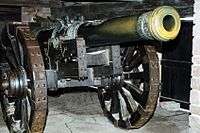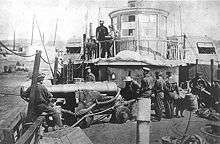Demi-cannon
| Part of a series on |
| Cannon |
|---|
 |
| History |
| Operation |
| By country |
| By type |
The demi-cannon was a medium-sized cannon, similar to but slightly larger than a culverin and smaller than a regular 42 lb (19 kg) cannon, developed in the early 17th century.[1] A full cannon fired a 42-pound shot but these were discontinued in the 18th century as they were seen as too unwieldy. The lower tier of 17th Century English warships were usually equipped with demi-cannons.
Ships featuring demi-cannons included HMS Sovereign of the Seas,[2] HMS Resolution[3] and HMS James, which fought in the Anglo-Dutch naval wars.[4] The barrels of demi-cannon were typically 11 ft (3.4m) long, had a calibre of 6 inches (15.4 cm) and could weigh up to 5600 lb (2540 kg). It required 18 lb (8 kg) of black powder to fire a 32 lb (14.5 kg) round shot. The demi-cannon had an effective range of 1600 ft (490m).[1][5]
-

16th-century German artillery, including number 4 in the top-right, a demi-cannon.
-

32 pounder smoothbore cannon, of 60 hundredweight, on a "Novelty Carriage". This mounting was developed by Commander Ward before the Civil War
These 32-pounders were used during the 18th century on first-rate three-decker ships of the line[6] which carried up to 100 guns. Though powerful, the naval demi-cannons were inaccurate except at close range so opposing warships would try to get as close as possible before firing their broadside in order to cause as much damage as possible; sometimes a single broadside was enough to cripple the enemy vessel.[7]
References
- 1 2 Artillery through the ages
- ↑ http://www.royal-navy.mod.uk/server/show/nav.3899
- ↑ Lavery, Brian (2003) The Ship of the Line - Volume 1: The development of the battlefleet 1650-1850. Conway Maritime Press. ISBN 0-85177-252-8.
- ↑ Colledge, J. J. and Warlow, Ben (2006). Ships of the Royal Navy: the complete record of all fighting ships of the Royal Navy, Rev. ed., London: Chatham. ISBN 978-1-86176-281-8. OCLC 67375475. Demi-cannon were also used on HMS Stirling Castle, the wreck of which was discovered in the Goodwin Sands. Several examples of this weapon were recovered from the site.
- ↑ English artillery 1626 to 1643
- ↑ http://sketchup.google.com/3dwarehouse/details?mid=44269362558d9c4885f7a3de54751f1b
- ↑ Stephen Biesty (ill.) and Richard Platt (author). (1993). Stephen Biesty's Cross-Sections Man-of-War. New York: Dorling Kindersley.